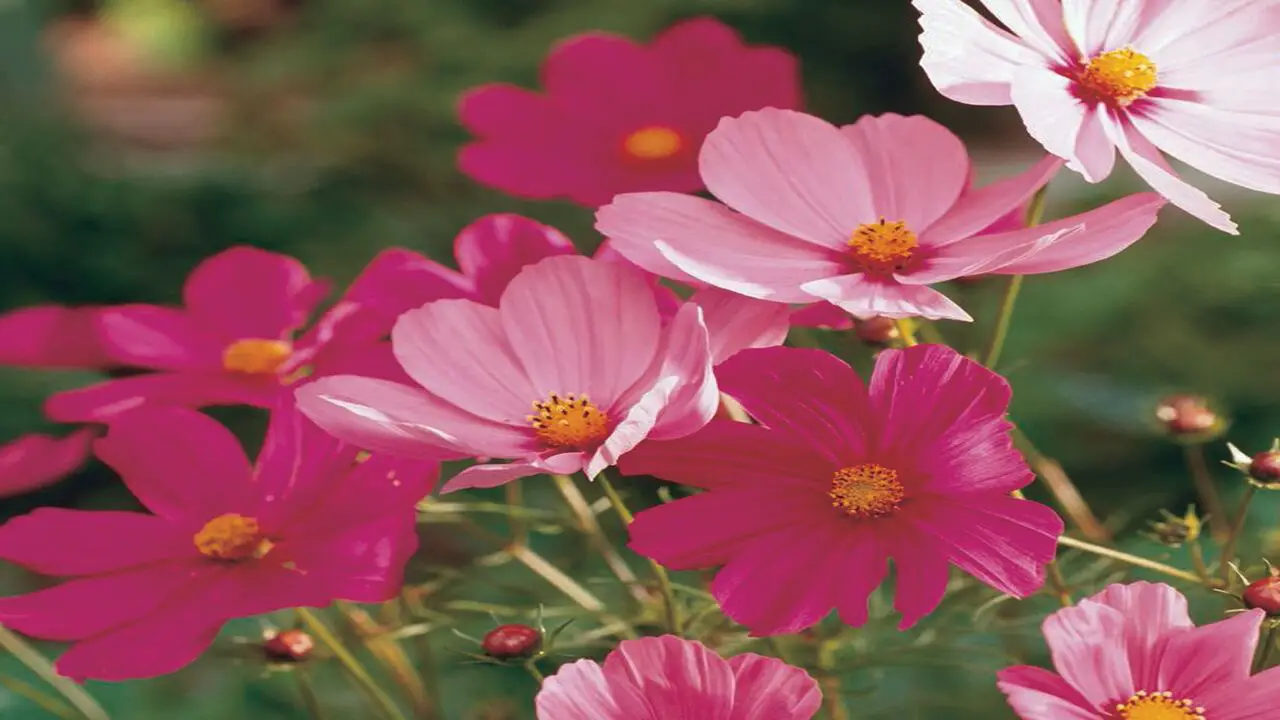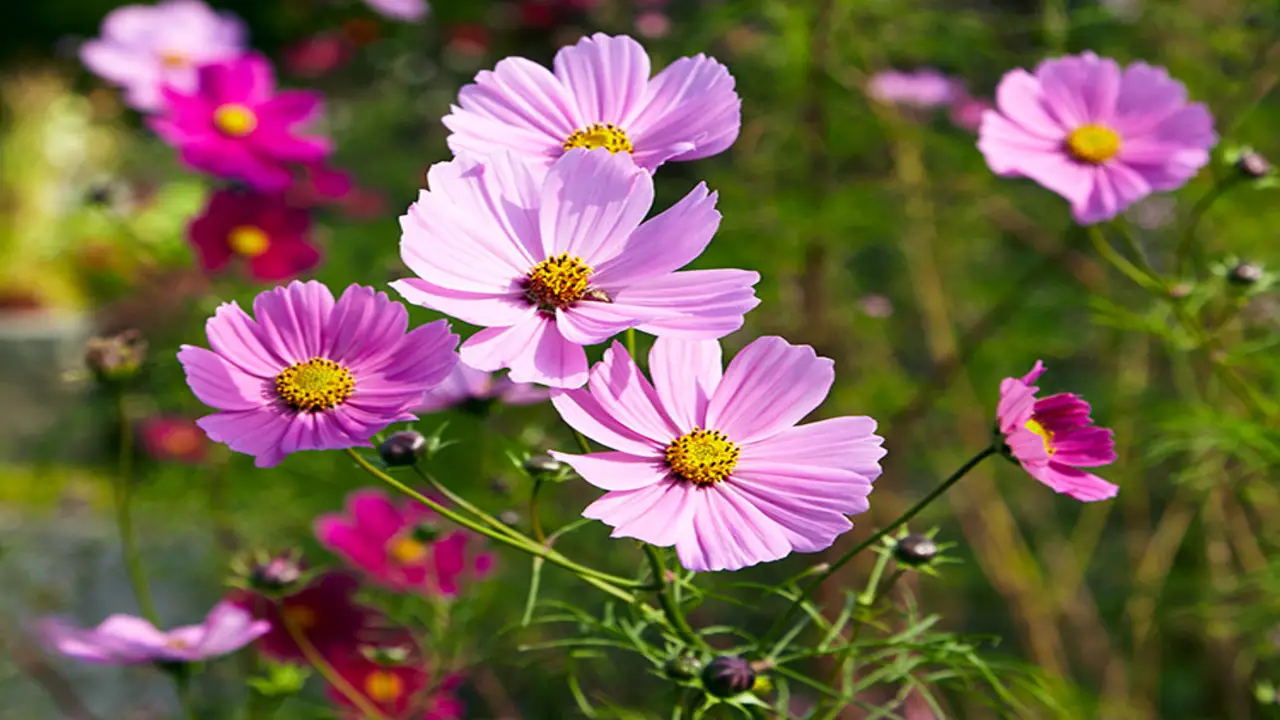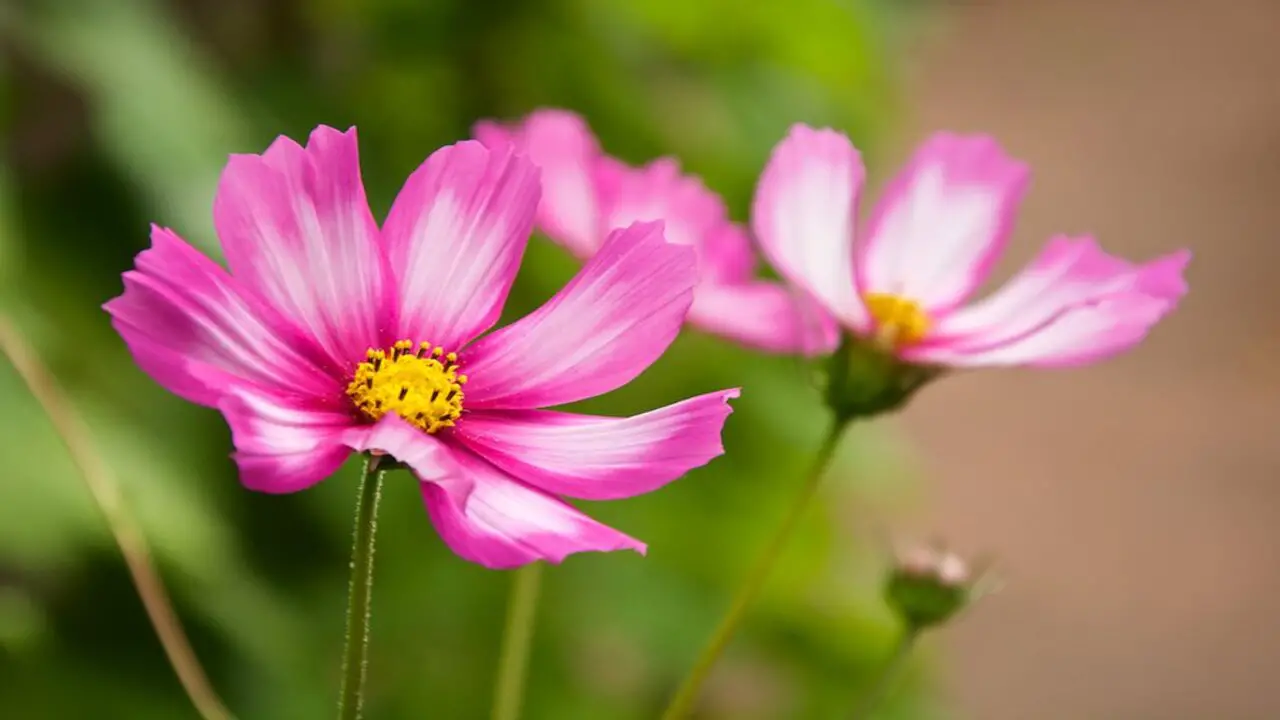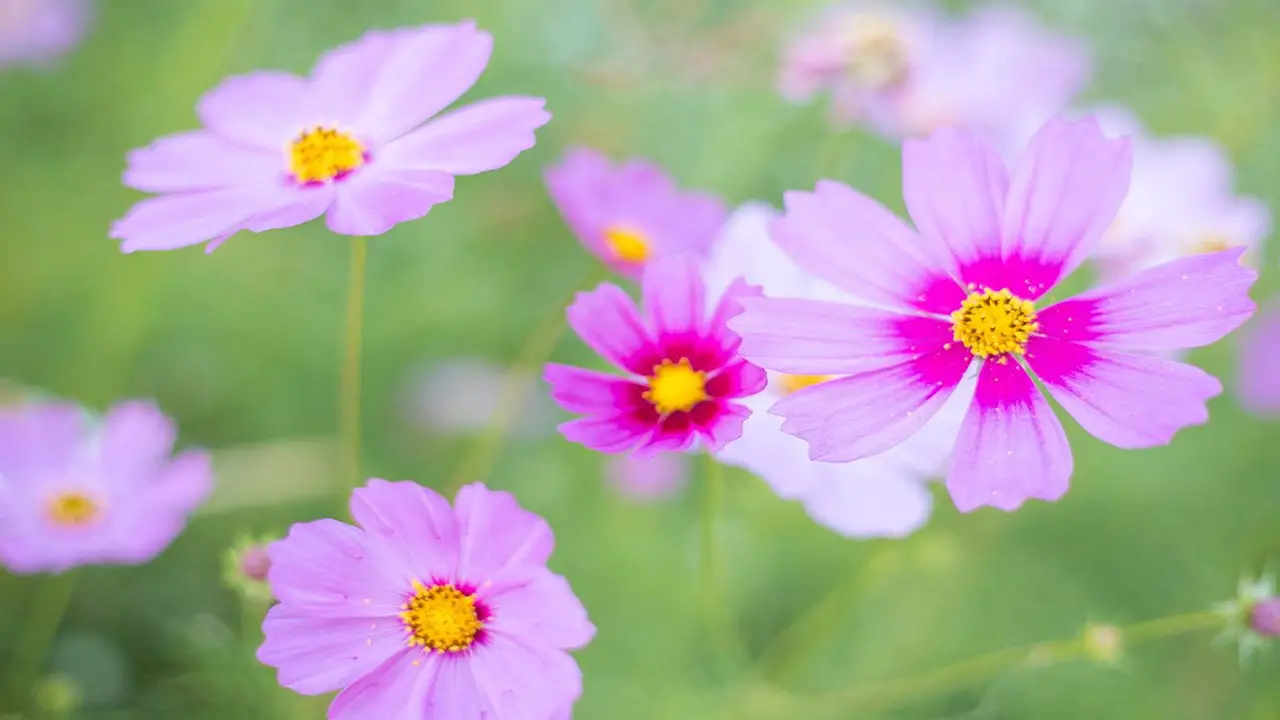The cosmos flower is a stunning addition to any garden and is known for its bright, colorful petals and delicate foliage. Whether you are an experienced gardener or just starting, planting Cosmos flowers can be a rewarding experience.
Here, we will cover everything you need to know about planting, growing, and caring for your cosmos flowers. You will learn about the different varieties of cosmos flowers and how to choose the perfect location for growing them.
We’ve also included eight tips to help your plants thrive, including proper watering techniques, fertilizing tips, and dealing with common pests and diseases. Additionally, we’ve included some creative ways to display your beautiful cosmos flowers once they bloom.

About Cosmos Flowers

Cosmos flowers are popular for gardeners due to their vibrant colors and easy cultivation. These annual flowers are native to Mexico and are known for their daisy-like blooms in pink, white, and purple shades. Cosmos plants can reach heights of up to 4 feet and have feathery foliage that adds an airy, delicate touch to any garden. They are also great for attracting pollinators like butterflies and bees.
Cosmos flowers are relatively low-maintenance and can tolerate various soil conditions. They prefer full sun but can tolerate some shade. To plant cosmos flowers, simply sow the seeds directly into the ground after the last frost date or start them indoors a few weeks earlier. With proper care and regular watering, you can enjoy a beautiful display of cosmos flowers in your garden all summer.
Understanding The Different Varieties Of Cosmos Flowers

When planting cosmos flowers, it’s important to understand the different varieties available. Cosmos flowers come in various colors, sizes, and growth habits, so knowing which type you want to plant can help you achieve the desired look in your garden. Some popular varieties include:
- Cosmos Bipinnatus: This is the most common variety and features daisy-like flowers in pink, white, and red shades. It grows tall and requires staking for support.
- Cosmos Sulphureus: This variety has vibrant orange and yellow flowers and is known for its bushy growth habit. It doesn’t require staking and is more compact than C. bipinnatus.
- Cosmos Atrosanguineus: Also known as chocolate cosmos, this variety has dark red blooms with a chocolate-like fragrance. It is smaller and works well in containers or as a border plant.
- Cosmos Parviflorus: This variety has smaller flowers in pink, white, and purple shades. It has a more delicate appearance and is often used as a filler plant in flower arrangements. By understanding the different varieties of cosmos flowers, you can choose the ones that best suit your garden design and personal preferences.
Choosing The Right Location For Planting Cosmos Flowers
Choosing the right location is key to their success when planting cosmos flowers. These vibrant, daisy-like blooms thrive in full sun, so selecting a spot in your garden that receives at least six to eight hours of direct sunlight daily is important. Cosmos also prefer well-draining soil, so make sure the area you choose has good drainage.
Additionally, consider the height and spacing requirements of the specific cosmos variety you are planting. Some varieties can reach up to four feet tall, providing enough space to grow and flourish. By selecting the right location for your cosmos flowers, you can ensure they have the best chance of thriving and adding beauty to your garden.
8 Tips For Plant, Grow, And Care Planting Cosmos Flowers

Soil preparation is essential for planting cosmos flowers. Add compost or organic matter to create well-draining soil. It’s best to plant cosmos seeds in late spring or early summer after the danger of frost has passed. There are 8 important tips when planting, growing, and caring for cosmos flowers. These vibrant and versatile flowers can bring beauty to any garden or landscape, but proper care is essential for their success.
1. Preparing The Soil For Planting Cosmos Flowers
Preparing the soil is an important step in planting cosmos flowers. These vibrant and beautiful flowers thrive in well-draining soil rich in organic matter. Remove any weeds or grass from the planting area to prepare the soil. Loosen the soil with a garden fork or tiller to a depth of about 6 inches.
This will help improve drainage and allow the roots of the cosmos flowers to penetrate easily. If the soil is heavy clay, consider adding compost or well-rotted manure to improve its texture and fertility. Once the soil is prepared, you can sow the cosmos seeds or plant seedlings according to the instructions. With proper soil preparation, your cosmos flowers will bloom beautifully and add color to your garden.
2. Planting Seeds Vs. Transplanting Seedlings
When planting cosmos flowers, you have two options: planting seeds or transplanting seedlings. Planting seeds is more common and cost-effective, allowing you to grow your flowers from scratch. However, this method requires patience, as it can take several weeks for the seeds to germinate and the plants to mature.
On the other hand, transplanting seedlings gives you a head start, as the plants are already established and ready to bloom. This method is ideal if you want instant gratification or miss the window for sowing seeds. Whichever method you choose, provide your cosmos flowers with adequate sunlight, well-drained soil, and regular watering for healthy growth and beautiful blooms.
3. Proper Watering Techniques For Cosmos Flowers

Proper watering techniques are essential for the healthy growth of cosmos flowers. These vibrant and resilient plants require regular watering, especially during dry or hot summers. However, it is important to strike a balance and avoid overwatering, as this can lead to root rot and other issues.
When watering cosmos flowers, keep the soil evenly moist but not soggy. A good rule of thumb is to water deeply once a week, allowing the water to penetrate the soil to a depth of at least 6 inches. This encourages the roots to grow deeper and increases the plant’s overall resilience.
Additionally, it is best to water in the morning or early afternoon, allowing the foliage to dry before evening and reducing the risk of disease. Following these proper watering techniques can help your cosmos flowers thrive and enjoy their beautiful blooms all season long.
4. Providing Adequate Sunlight For Optimal Growth
Cosmos flowers thrive in full sunlight, so providing them with adequate sun exposure for optimal growth is important. Ideally, they should receive at least 6-8 hours of direct sunlight each day.
When choosing a location for planting cosmos flowers, look for an area that receives the most sunlight throughout the day. This can be a sunny spot in your garden or a well-lit balcony or patio. You can promote healthy growth and vibrant blooms by ensuring that your cosmos flowers receive enough sunlight.
5. Fertilizing And Nurturing Cosmos Flowers
To ensure the healthy growth and abundant blooms of your cosmos flowers, properly fertilize and nurture them throughout the growing season. Applying a balanced fertilizer every 4-6 weeks will provide the necessary nutrients for their development. Consider using a slow-release fertilizer or organic compost for sustained nutrient release.
Be cautious not to over-fertilize, as this can result in excessive foliage growth at the expense of blooms. Regular monitoring for nutrient deficiencies or excesses is recommended, and mulching around the base of the plants helps conserve moisture and suppress weeds.
6. Dealing With Common Pests And Diseases

To ensure the health and vitality of your cosmos flowers, it’s important to monitor for common pests such as flea beetles, aphids, and spider mites. Consider using organic pest control methods like neem oil or insecticidal soap if you notice any infestations.
Additionally, look for fungal diseases like powdery mildew or gray mold. To prevent the spread of diseases, ensure good air circulation by spacing your plants adequately and promptly removing and destroying any infected plant material.
7. Pruning And Deadheading Cosmos Flowers For Continued Blooming
Pruning and deadheading cosmos flowers are essential for ensuring continued blooming throughout the growing season. Deadheading, or removing spent flower heads, encourages the plant to produce new blooms. Cutting off the faded flowers redirect the plant’s energy towards developing new buds.
Additionally, pruning can help to maintain a compact and tidy appearance for your cosmos plants. To deadhead cosmos flowers, simply snip off the spent blooms just above a set of healthy leaves or branching points. Regular deadheading and occasional pruning will keep your cosmos plants looking vibrant and full of color all season long.
8. Harvesting And Saving Cosmos Flower Seeds
Harvesting and saving cosmos flower seeds is a simple process that allows you to enjoy these beautiful flowers year after year. To harvest the seeds, wait until the flowers have fully bloomed and the petals have fallen off. You will see a round seed head in the center of the flower.
Gently pluck the seed head from the plant and place it in a paper bag or envelope to dry. Once dry, shake the seed head to release the seeds. Store the seeds in a cool, dry place until you can plant them in your garden or share them with fellow gardeners. By saving cosmos flower seeds, you can continue to enjoy their vibrant colors and delicate blooms for future seasons.
Troubleshooting Tips For Common Issues In Growing Cosmos Flowers

When growing cosmos flowers, gardeners may encounter a few common issues. However, with some troubleshooting tips, these problems can be easily addressed to ensure successful cultivation of these beautiful plants. Addressing these common issues ensures that your cosmos flowers grow healthy and vibrant, adding beauty to your garden.
- Lack of blooming: If your cosmos flowers are not blooming, it may be due to insufficient sunlight. Cosmos flowers require full sun for at least 6-8 hours daily. Make sure to plant them in a sunny spot in your garden.
- Overwatering: Overwatering can cause root rot and prevent the cosmos flowers from thriving. Water them sparingly, allowing the soil to dry out between waterings.
- Poor soil quality: Cosmos flowers prefer well-draining soil with good fertility. Add organic matter such as compost or peat moss to improve drainage and nutrient content if your soil is heavy or clay-like.
- Pest infestation: Common pests affecting cosmos flowers include aphids, spider mites, and slugs. Monitor your plants regularly and take appropriate measures, such as using insecticidal soaps or organic pest control methods to prevent and manage pest infestations.
- Competition from weeds: Weeds can compete with cosmos flowers for nutrients and water. Regularly remove weeds from the vicinity of your cosmos plants to ensure they have ample resources to grow and thrive.
Creative Ways To Enjoy And Display Cosmos Flowers.
Planting cosmos flowers can bring color and beauty to any garden. But why stop at just admiring them in the garden? There are many creative ways to enjoy and display cosmos flowers indoors and outdoors. Here are a few ideas:
- Create A Cosmos Bouquet: Cut some cosmos flowers and arrange them in a vase for a stunning floral centerpiece.
- Press Cosmos Flowers: Preserve the beauty of cosmos flowers by pressing them between heavy books. Once dried, they can be used for crafts or framed as artwork.
- Make Flower Crowns: Use cosmos flowers and other blooms to create whimsical crowns for special occasions or photoshoots.
- Dry Cosmos Petals: Dry the petals of cosmos flowers and use them to create potpourri or natural confetti for weddings or celebrations.
- Decorate Your Outdoor Spaces: Plant cosmos flowers in containers or hanging baskets to add color and vibrancy to your patio or balcony.
These creative ideas allow you to fully enjoy the beauty of cosmos flowers beyond their presence in the garden, bringing their charm into your everyday life.
Conclusion
Growing and caring for cosmos flowers can be a rewarding experience. With the right knowledge and techniques, you can enjoy beautiful blooms throughout the season. Whether you choose to start from seeds or seedlings, it’s important to provide proper soil preparation, watering, sunlight, and fertilization for optimal growth.
Don’t forget to address common pests and diseases that may affect your plants. Pruning and deadheading will help promote continuous blooming. Harvesting and saving seeds allow you to propagate more cosmos flowers in the future.
And finally, get creative with different ways to enjoy and display these vibrant and versatile flowers. So plant some cosmos and enhance your garden with their beauty. We hope you understand planting cosmos flowers.
Frequently Asked Questions
1.What Is The Best Month To Plant Cosmos?
Ans: The ideal time to plant cosmos is spring, after the last frost. In warmer regions, fall planting is also an option. Whether you sow seeds directly into the soil or start them indoors and transplant them later, select a sunny location with well-draining soil.
2.Do Cosmos Come Back Every Year?
Ans: Cosmos are annual plants, completing their life cycle in one season. However, they easily self-seed, allowing new plants to grow the following year. To encourage reseeding, leave spent flowers until they dry out or collect seeds for next year’s planting.
3.How Do You Plant Cosmos Flowers?
Ans: To plant cosmos flowers, choose a sunny spot with well-draining soil. After the last frost, sow seeds directly into the soil, spacing them 12-18 inches apart and planting them 1/4 inch deep. Water regularly without overwatering.
4.Can I Just Scatter Cosmos Seeds?
Ans: Scattering cosmos seeds is a simple and effective way to plant them. Choose a sunny spot with well-draining soil. Plant the seeds in early spring or after the last frost. Remember to water regularly, and deadhead spent blooms for continuous flowering.
5.Why Are My Cosmos Not Flowering?
Ans: Possible output: Possible reasons for cosmos not flowering include excessive nitrogen fertilizer, inadequate sunlight exposure (they require at least 6 hours of direct sunlight per day), overcrowding (ensuring sufficient space for growth), and failure to deadhead spent blooms regularly.







